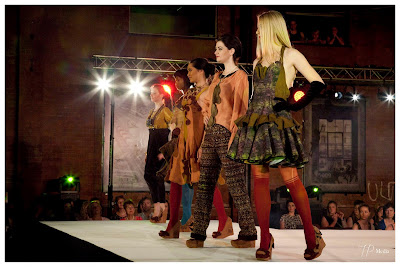It has come to the end of university and nows the time to find a job, graduate this september, help out with this knit show at the Hub in Sleaford and promote myself at the Graduate Fashion week in London, oh yeah and also of all things pay all the depts that university has very nicely built up through the last three years.
Everything went better than expected. There were moments where I nearly set my knitting machine on fire, threw the overlocker out my window, crushed the sewing machine or even nearly lost my cool with the teachers, but thank goodness I managed to keep my self together.
I managed to get some wonderful friends to model in my outfits for the critique. I couldn't have better models. They even came over a few days before so I could work out what accessories and shoes to match. They had no hesitation. Lots of thanks to Jodie, Danny, Lisa and Jen. For the critique we were to create four finished outfits, this was a success and the lecturers seemed very delighted by the collection, I managed to get some lovely compliments and was told to create another outfit using the spare materials to add with the four others for the catwalk.
Within two days I managed to design and make this silk dress just in time for when the teachers were choosing which outfits would go on the catwalk. Luckily all five outfits were accepted but I was told to do plenty more. They didn't believe that I would be able to finish all the jobs given but being myself I do love to surprise, teehee!! Above all the jobs that they gave me I also managed to make a necklace with my knitted faces on, make a bracelet which wasn't used in the end, buy accessories, make a vintage camera a neck piece and decorate my shoes using a soldering iron and some knit. I was determined to get that one picture from my imagination into a real thing.
Here's the illustration for the four outfits of my collection.

My collection was called 'Enticing Extramundane'. The research for the theme started from this book which I read during the summer called Banners of Silk by Rosalind Laker, a book that my great aunty Betty gave to me which happened to drop out of my bookshelf one day with a little note saying 'read me'. It's about a seamstress who worked for a very well known English designer called Charles Worth who made his success in France in the mid 1800s.
I was determined to use Charles Worth as inspiration after reading this book so I used that period as my main goal and realised that the Paris opera house was built at a similar time bringing me to a musical which my friend Natalie introduced to me on the first year of university called Phantom of the Opera. I wanted to bring the music into the garments, that organ. I tried to put together elegance at the same time as something beyond the physical world. I used baroque and gothic architecture to bring structure and detailing into the garments. Masquerade balls seemed to enter in like a lightning bolt during the design process steering me to the knitted faces. My intention was to go beyond my imagination. Though I did go to a point where I thought I was going too far leading me to making two of the outfits less extreme as intended, but I believe it all worked out well anyways.
Below are some photographs of my collection on the catwalk at the University of Lincoln Fashion Show.
The dress at the front is my own design print on fabric using Lincoln Cathedral as inspiration. It took many attempts to print but eventually was solved.
The photograph above is of the outfit which was made after the critique. You can see on the shoes my attempt at drawing eyes with the soldering iron and applying knit for the lips.

This outfit is my favourite out of the lot as it certainly took the longest to make. The top is four faces attached to each other, one on each side of the bodice, one at the front and one at the back. The main piece has been knitted by machine with an extensive amount of mathematics involved. The lips and eyes are hand knitted onto the piece. The skirt below was machine knitted by myself as well with a velvet lined skirt underneath fastened at the waist to hold the weight of the knit.

 Due to the new inventions which speeded the process of spinning and weaving based mainly around Lancashire during the industrial revolution of 1750-1850, the older industries which were in places like Stamford and Lincoln declined and never recovered.
Due to the new inventions which speeded the process of spinning and weaving based mainly around Lancashire during the industrial revolution of 1750-1850, the older industries which were in places like Stamford and Lincoln declined and never recovered.







